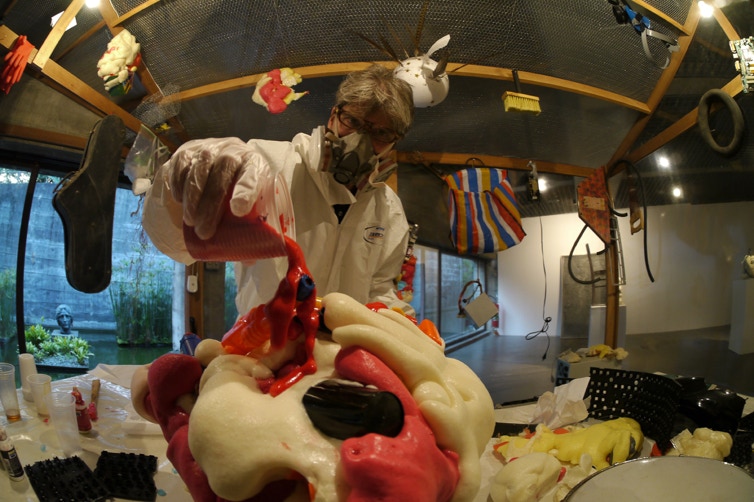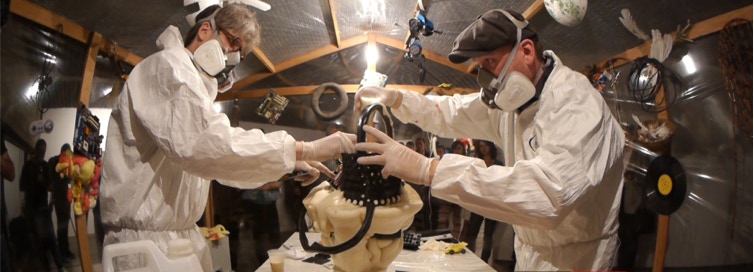
F O R M L A B




FormLAB (FormLaboratory) is an art series conceived by artist Les Joynes (US) in 1997 at Goldsmiths (London) as a experimental art laboratory. FormLAB unpacks and explores the root-processes of art-making and installs open-laboratories in museums that experiment with new media and technologies. As a project FormLAB explores not only the interplay between different media but also the Post-Digital and draws from inter-artist experimentation and excavations of the unconscious through collaboration.[1]
(images above, Les left in a FormLAB assembly line at the Brazilian Museum of Sculpture, Sao Paolo, 2012).
FormLAB uses technology to explore disappearance of neighborhoods (Singapore, 2009); construct art-making assembly-lines (France, 2010, Korea, 2012); engage indigenous technologies and magic (Brazil, 2012); interface digital with traditional (Mongolia, 2014); investigate borderland on the Great Wall (China, 2017); and now designs new work using C++ code-controlled macro-robotic geolocated systems (city-wide installations) that engage spectators and entire neighborhoods in smartphone networked exhibitions.
Joynes has exhibited at Seoul Foundation for Art and Culture, Korea; Brazilian Museum of Sculpture; Zanabazar National Museum of Art, Mongolia; Inside Out Art Museum, Beijing; Art Miami; Thomas Jaeckel Gallery, New York; Michael Steinberg Gallery; Norimatsu Museum, Japan; Brazilian Museum of Sculpture, São Paulo; Åmotgård Museum, Norway; Fenberger Museum, Japan; University of Minnesota; Milch, London; and NyLon, London. (above, video still from multi-technology performances, France, 2010)
Each LAB positions itself within spaces that capture and preserve time and become temporary “living dioramas” that present instants of artistic creation, uncertainty, discovery and the unexpected. (1) particularly in spaces in what Robert Smithson referred to as hideouts of time (“Entropy and the New Monuments," Artforum, June 1966). In this way, FormLAB relocates our gaze towards real-time experiences within sites and exhibition spaces. (above, US-China performances on the Great Wall, 2017: Shifting 0.00000000103279% of the Great Wall (2 min 50s) - inspired by Maurits Cornelis Escher;; One-on-Two-on-One (2 min) and Globe / Balance 0.30 sec. Below FormLAB Performances, Zanabazar Museum of Art, Ulaanbaatar, Mongolia, 2014).
Notes
_________________________
[1] inspired by post-YBA British DIY, the notion of the artist as Semionaut (Bourriaud) as well as the Andre Breton’s Cadavre Exquis (1918) and L’Amour Fou (1937), Bauhaus experimental performance, and William Burroughs’ Cut-Ups (1970). In the early 2000s curators began to express an interest in the notion of the laboratory as ‘still untouched by science’ from “Laboratories is the answer, what is the question?” TRANS 8 (2000) from Bishop, Clare, (2004) Antagonism and Relational Aesthetics: October (Fall 2004): pp. 51-79.
(2) As Maurice Blanchot wrote “Interruptions having somehow the same meaning as that which does not cease. Both are affects of passivity. Where power does not reign – nor initiative, nor the cutting edge of a decision – there, dying is living. There dying is the passivity of life – of life escapes freed from itself and confounded with the disaster of a time without present which we endure without waiting, by awaiting a misfortune which is not still to come, but which has always already come upon us and which cannot be present.” Blanchot, Maurice, The Writing of the Disaster, University of Nebraska Press, Lincoln, 1986, p 21
The informe (or formless) is defined by Georges Bataille in Documents (1929) as “…not only an adjective having a given meaning, but a term that serves to bring things down in the world, generally requiring that each thing have its form. What it designates has no rights in any sense and gets itself squashed everywhere.” In Bataille, G (1929), Documents 1, Paris, p. 382 (translated by Allan Stoekl et al, Georges Bataille. Vision of Excess. Selected Writings, 1927-1939, Minneapolis: University of Minnesota Press “Formless”, p. 31).

All Rights Reserved 1996-2019 © FormLAB, Les Joynes Joynes LLC, ARS, New York and DACS London.

